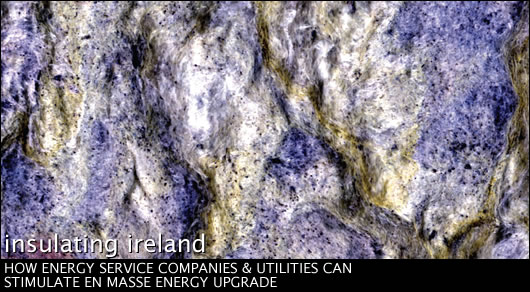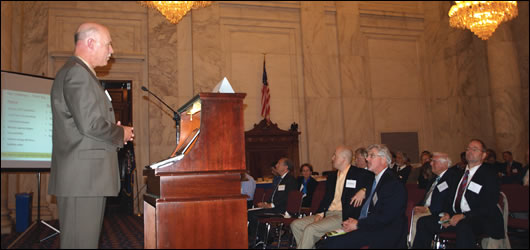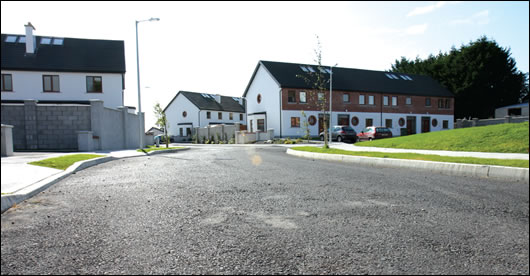- Design Approaches
- Posted
Insulating Ireland

The vast majority of Irish buildings are in need of substantial energy upgrade work. Given the difficult economic conditions and low public awareness of the cost, comfort and health benefits of a well-designed energy renovation, the notion of upgrading most Irish buildings is a considerable challenge. However, as Lenny Antonelli explains, new ideas are emerging that could stimulate energy upgrade work on an unprecedented scale.Last year, the Construction Industry Federation (CIF) called on the government to spend e1.3 billion over six years grant-aiding the upgrade of an estimated 900,000 Irish houses built before the first energy-related building regulations were introduced in 1990. In an interview with Construct Ireland, CIF director general Tom Parlon said such a project “would provide a massive amount of work, and all of the associated benefits to the state.”
Such an investment would be huge, but it wouldn’t necessarily be unprecedented. The German government has committed to upgrade all houses built before 1978 at a cost of e1.5 billion. Efforts here have been small by comparison: last year’s five million euro pilot of the Home Energy Saving Scheme grant-aided the energy upgrade of about 1,500 homes, and e20m has been earmarked for the scheme in 2009. While this is a step in the right direction, it represents only a fraction of the investment needed to slash carbon emissions from Ireland’s housing stock - an investment it’s hard to see the state making in the current economic climate.
But cutting residential emissions must nonetheless remain an urgent priority - they account for a quarter of Ireland’s carbon emissions, and according to a report by the US Commission for Environmental Co-operation are a much easier target for emission slashing than sectors like agriculture or transport. “It’s probably easiest (to reduce emissions) in the built environment. The new-build side can be managed in terms of regulations, but the big challenge is existing buildings,” energy minister Eamon Ryan told Construct Ireland. So how can hundreds of thousands of people be convinced to upgrade their homes?
Grants like the Home Energy Saving Scheme are one option. While full details had yet to be announced as Construct Ireland went to press, this year’s scheme is expected to grant aid measures such as insulation, high efficiency boilers and heating controls. While grants may be effective in stimulating a new market, they’re unlikely to convince hundreds of thousands of homeowners to renovate even if sufficient funding were available, as the Greener Homes Scheme has shown.
“I’ve always said that grants aren’t supposed to be there forever,” Ryan says. “When grants have scaled up an industry and the supporting infrastructure is in place you can start to scale back the grants. You can see that in how the Greener Homes Scheme worked.”
Perhaps if the government cobbled together enough funding to offer generous grants to homeowners while meeting the cost of upgrading social housing itself, a serious dent could be made in Ireland’s residential emissions. There could be a much more effective way to achieve that goal though. For decades, energy service companies (ESCos) have profited by performing energy upgrades of buildings.
The principle is simple: the ESCo upgrades a building and in turn reduces its energy demand and bills. The building occupant pays nothing initially, then pays for the work done over time with the money saved through the reduced energy bills. Sometimes the ESCo and building occupant agree to split the energy cost savings according to an agreed ratio, and in this case the bigger the reductions in energy demand resulting from the upgrade, and the less energy the occupant subsequently uses, the more each will make. Under another model, the ESCo guarantees a reduction in energy demand resulting from the upgrade work, and if the savings turn out to be less than guaranteed the ESCo compensates the building owner. Regardless of the model, the advantage of this kind of approach is that it can enables energy upgrades without any initial investment from the building owner. The owner pays nothing up front and ends up with lower energy bills, the ESCo makes a profit, and energy consumption is reduced.

CIF director general and Construct Ireland editor Jeff Colley discuss ideas for the energy upgrading of Ireland’s existing housing stock
The Bill Clinton-led Clinton Climate Initiative (CCI) has been at the forefront of pushing this approach. The group has teamed up with four multinational ESCos with the aim of upgrading large public and private buildings across 40 major international cities. The CCI will organise buildings into clusters to maximise efficiency, while the ESCos will guarantee energy savings from upgrade measures. All parties will adhere to a set of best practice guidelines developed by the CCI, while five international banks - including JP Morgan Chase and Citibank - have agreed to provide $1 billion each in loans for the project, which will be repaid over time through the reduced energy costs.
But if both building owners and ESCos can make a profit from energy upgrades, why hasn’t every house in the country been refurbished by now? ESCos are often less keen to engage with large numbers of small clients because a certain proportion will inevitably default on their repayments. It can also be expensive for ESCos to undertake upgrade work and administer billing across thousands of households. A study published by the European Commission’s Institute for Energy found that only 11 per cent of ESCos were willing to work with a client whose annual energy bill was less than e10,000. However Mark Coyne, technical director at the Irish office of multinational ESCo-provider Dalkia, says the company is looking closely at entering the residential market.
“We have a strong appetite for the residential market. We see lots of opportunities there,” he says. Coyne sees attic and wall insulation, boiler upgrades and the retrofitting of proper heating controls and zoning as the most effective upgrading measures. “Our focus would be to zone in on the pre-building regulation stock,” he says, adding that it is too early to say what kind of contracting model would work best on a residential scale.
The Irish Environmental Network (IEN), an umbrella group for Irish environmental NGOs, will propose a programme to stimulate the en masse energy upgrade of the housing stock when it joins the social partnership talks in the coming months. A draft plan seen by Construct Ireland proposes that the government would lend money to homeowners for energy upgrades from the National Pension Reserve Fund at a low rate of interest, with energy service companies - perhaps fostered by an SEI accelerated training program - overseeing a full suite of upgrades to participating homes. ESCos would tender for suitable contractors to carry out the work and then manage contracts with homeowners. Building Energy Rating assessments would be carried out on participating houses before and after refurbishment. “I think we have to let householders know what their new energy rating will be if they put the money in,” says IEN’s James Nix, co author with Irish times environment editor Frank McDonald of Chaos at the Crossroads. The IEN is currently inviting interested parties to comment on its proposals.
Public utilities could get involved in such a programme too. Unlike most private ESCos, public utilities have the administrative capacity to deal with hundreds of thousands of individual households. They’re also a trusted brand that might find it easier to convince homeowners to retrofit. The ESB and Bord Gáis could undertake energy upgrades of households and then recoup the cost, and their profit, on customers’ bills over time. Such a model would give Bord Gáis the opportunity to expand its business model to the hundreds of thousands of homes not connected to the gas network. If a homeowner wanted to switch their energy provider, the new supplier could buy out the full amount owed by the customer from the current supplier, or the customer could simply continue to make capital repayments to one company while paying another for energy supply.
Of course with energy prices likely to rise in the coming decades as supply contracts, it will be impossible for utilities or ESCos to guarantee that household bills will remain lower than before the upgrade was carried out. But upgrading a house to reduce its energy demand will leave homeowners much less exposed to future energy price rises, so they’ll still save money. In the draft version of the proposal it intends to bring to social partnership talks, the IEN has proposed another idea to help keep bills down as energy prices rise in future - varying the period over which homeowners pay for the upgrade work depending on energy costs. If the price rises, the period is extended and annual repayments are reduced. “We see a massive case to move to a situation where…the repayment period can vary depending on the cost of energy,” Nix says.
There are precedents for utilities trying to reduce energy demand in the housing stock. After the 1979 oil crisis, the ESB teamed up with Moy Insulation to install fibreglass in 30,000 attics, and then added the cost to customers’ electricity bills over a period of three to five years. “We didn’t actually install the insulation ourselves, but we appointed local contractors,” explains Patrick Duffy, former managing director of Moy Insulation and currently head of NICER Training. From next March, the ESB will insulate 1,000 homes under the government’s Warmer Homes Scheme, which aims to relieve fuel poverty. The cost of the work will be spread evenly over all ESB customers’ bills.
Unfortunately there’s little incentive for the ESB or Bord Gáis to perform energy upgrades on their own initiative without government intervention. Most utilities globally make more money when they sell more energy. This is one of the main obstacles to reducing energy use in buildings globally - while governments might want to reduce consumption, it’s not always in energy companies’ interest to do so. Though this is a bigger issue in countries where utilities have been privatised and are under less state control, the link between how much energy a utility sells and how much profit it makes should nonetheless be broken in Ireland too, so that our energy utilities are more profitable when they reduce rather than increase energy consumption. If that were the case, they’d be much quicker to jump on the retrofitting bandwagon.

Michael W. Taylor, Honeywell’s vice president of sales, speaking at a Clinton Climate Initiative event. Honeywell are one of four multinational ESCos working to upgrade large public and private buildings in 40 cities around the world
“Nothing’s going to change unless we reinvent the way that firms distribute and derive profits from energy,” Allan Asher, former chief executive for the defunct UK watchdog Energywatch, told The Times. “The first thing to do is to break the link with ever-increasing sales and consumption.”
In the UK, big energy utilities are obliged to make specific reductions in energy consumption by promoting efficiency and upgrading buildings. Eamon Ryan told Construct Ireland that similar measures would be introduced here next year. Another way of tackling the link between energy consumption and utility profit is decoupling, whereby the state financially compensates utilities – or allows them to increase charges – when there is a reduction in energy demand arising from energy efficiency projects. California introduced decoupling in 1982, and its per capita electricity consumption has remained static for the last three decades while the rest of the US’s has risen by half.
The New England Independent System Operator (NEISO) is pioneering an innovative new take on decoupling called the forward capacity market. It works like this: NEISO forecasts energy demand three years in advance, and then auctions off the rights to meet demand to whoever can provide it for the lowest cost. The auctions are relatively open, and bidders can meet demand through traditional = generation in power plants, microgeneration and - here’s the crunch - energy saving measures too. So if an ESCo can save 1MW of energy by insulating homes for less than it costs a power company to generate the same amount, it wins the auction and the right to supply the energy. At the first auction in February last year, 626MW were auctioned to supply-side providers, with 1,188MW going to demand side projects, sometimes called ‘virtual power plants’. All new demand-side applications must submit to a monitoring process to verify reductions.
Another innovative way of breaking the link between energy consumption and utility profit is to fix the cost of customers’ energy bills. The November 2088 issue of Construct Ireland profiled developer Ronan Meeley’s Oak Hill housing estate in Moate, County Westmeath. Meeley provides heat to residents through a wood-pellet fired district heating system and charges a flat rate of e600 annually for heating, provided residents don’t use more than that 4,500kWh in a year – a surprisingly achievable target, due to the homes modest size and high energy efficiency levels. If they do, Meeley charges 7c per extra kWh used. By fixing the price, Meeley makes more money when residents use less heat – because he’ll have to buy less fuel but will still make the same amount - and has a strong incentive to make energy demand in the houses as low as possible.
Could a public utility or energy service company apply the same principle to a housing retrofit program? Let’s say your annual heating bill is e2,000. The ESCo or utility would take out a loan and pay one or more contractors to perform a full suite of energy upgrades. If this reduced your energy bill to e1,500, the utility could fix the annual bill at a price between e1,500 and e2,000 that enables it to recoup its own investment and make a profit over a set number of years. If your energy consumption goes over a certain limit, you’ll be charged an agreed rate per kWh. The annual bill would be tied to the wholesale cost of energy, so that if global energy costs rise next year’s set price would be higher than last.
Under this fixed price model model, the ESCo or utility would have a strong incentive to reduce your home’s energy demand as much as is it can cost-effectively. Unscrupulous ESCos might think that if they do little to improve your home’s energy performance their profits will be greater, because they’ll be guaranteed a fixed price but will have little capital investment to make. To help avoid this, BER assessments would be an integral part of the process - they’d be carried out before and after refurbishment work, and ESCos would offer a guarantee of the BER boost that would result from upgrade work. All ESCos and contractors involved would be centrally regulated, with records of their past work publicly available to verify its quality.
While BERs could prove that energy demand in a house has fallen, any reduction in energy bills means there’s a danger of the ‘rebound effect’ occurring - the phenomenon whereby people with newly insulated and more comfortable homes, and more money in their pockets from reduced bills, decide to unnecessarily heat part of their homes they previously hadn’t, or to take more baths instead of showers. There’s also the danger that if the annual heating bill were fixed it would remove the financial incentive that currently exists for homeowners to use less energy.
There are a number of ways of avoiding these issues. Ensuring upgrades result in good BER jumps and include the installation of simple controls and zoning should reduce consumption regardless, while setting the energy consumption ceiling that’s tied to the fixed price at a level that isn’t too high would also prevent overuse. However, Patrick Duffy doesn’t see a need to fix the consumer’s energy bill. “The more the price of energy goes up the more the consumer is saving, so you don’t really have to fix it.”

ESB chief executive Padraig McManus, energy commissioner Dermot Nolan and energy minister Eamon Ryan pictured at the launch of the national smart metering plan in September. McManus can play a key role in financing en masse energy reduction by developing ideas ESB has already successfully implemented. The utility was behind a successful initiative in 1980-81 to insulate 30,000 attics, adding the insulation cost to the ESB bills of the homeowners who benefited
Indeed a variety of business models based on reducing household energy demand are worth examining. A shared savings model, where the customer and ESCo split the energy cost savings to a pre-arranged ratio, would give the customer the incentive to reduce their energy use and the ESCo the incentive to lower energy demand as much as possible. Alternatively the system could be based on units of energy rather than money, so that if a house uses 100 units of energy a year the ESCo will reduce that to 60 through upgrade measures it pays for up front, and then subsequently charge the customer for 90 units, regardless of wholesale energy costs.
Whatever the model, any scheme is most attractive for both the homeowner and ESCo - and the ‘rebound effect’ is best prevented - when fossil energy prices are somewhat high. If energy prices were to fall after your home had been upgraded, you might question if it had been worthwhile. One way of keeping prices high is Cap and Share – a carbon trading mechanism devised by Feasta, the foundation for the economics of sustainability, under which the total amount of carbon that can emitted annually is capped and subsequently lowered every year. Another would be to increase the tax on fossil fuels if the price falls below a certain floor. Eamon Ryan agrees that financial incentives are key. “You have to put a price on carbon, then the market itself starts to respond to that price by reducing carbon. I think that’s an efficient way of effecting change.”
If the CIF’s desire to see 900,000 homes upgraded is to become a reality, a carrot and stick approach is needed. The state must make an effort to get things started: it can provide targeted grants, properly regulate ESCos and develop best practice guidelines, and nudge our utilities towards changing their business models so they profit from energy reduction rather than consumption. It could also help to make finance for energy upgrades available to homeowners with poor credit ratings, say through the National Pension Reserve Fund, and to provide grants for ESCo start-ups. At the same time our public utilities are likely to act much faster - and a new industry of residential ESCos is likely to emerge - if there’s money to be made in reducing energy demand in the housing stock.
Acting separately neither the public, semi-state or private sector is likely to bring about an en masse energy upgrade of the housing stock. Put them together, though, and it could become a lot more feasible.

Ronan Meeley’s Oak Hill housing estate in Moate, County West Meath, where homeowners are sold fixed price heat through an ESCo
- Articles
- Design Approaches
- Insulating Ireland
- Energy upgrade
- economy
- Construction Industry Federation
- home energy saving scheme
- insulation
- emissions
- ESCo
- Clinton Climate Initiative
- Carbon Tax
Related items
-
 New Ejot profile cuts thermal bridging losses by 25mm insulation equivalent
New Ejot profile cuts thermal bridging losses by 25mm insulation equivalent -
 Green shoots for green building
Green shoots for green building -
 Ireland’s first 3D printed homes insulated with clay foam
Ireland’s first 3D printed homes insulated with clay foam -
 Much ado about nothing
Much ado about nothing -
 Unilin Ireland launches embodied carbon report
Unilin Ireland launches embodied carbon report -
 Ecological launches Retro EcoWall for internal wall insulation
Ecological launches Retro EcoWall for internal wall insulation -
 Xtratherm name changes to Unilin
Xtratherm name changes to Unilin -
 Ecological Building Systems launch Retro EcoWall for internal wall insulation
Ecological Building Systems launch Retro EcoWall for internal wall insulation -
 Decarbonising buildings “most important issue” – Climate Change Committee
Decarbonising buildings “most important issue” – Climate Change Committee -
 Kore launches low carbon EPS
Kore launches low carbon EPS -
 Kilsaran gets NSAI cert for EWI to steel frame
Kilsaran gets NSAI cert for EWI to steel frame -
 Steico offering free wood fibre insulation samples
Steico offering free wood fibre insulation samples

